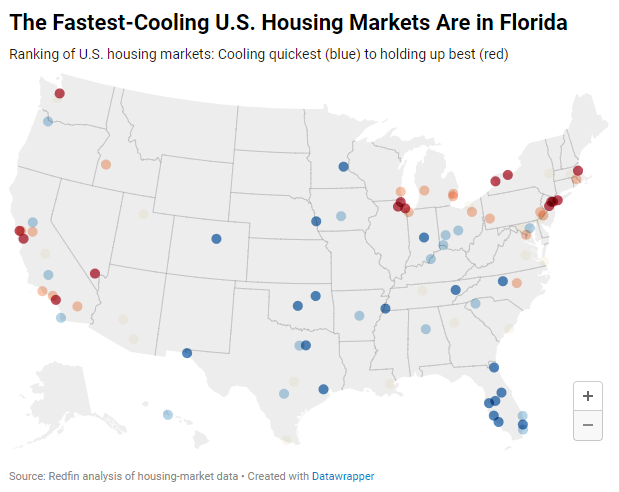A new-construction boom is contributing to listings surging to pre-pandemic levels on Florida’s west coast, cooling competition during a period when natural disasters and rising insurance costs are already discouraging homebuyers. But while high housing costs are hampering many U.S. housing markets, Rochester and Buffalo are heating up, with homebuyers attracted to relatively low prices.
Housing markets in western Florida are cooling faster than anywhere else in the country as natural disasters intensify, new construction soars and the pandemic-era homebuying demand boom fades further into the rearview mirror.
North Port’s housing market is cooling fastest, followed by Tampa and Cape Coral. There are three other Florida metros on the list of 10 housing markets cooling quickest: Orlando, FL comes next, followed by Denver, Houston, Minneapolis, Jacksonville, FL, Lakeland, FL and Dallas.

This is according to a Redfin analysis that ranks the 100 most populous U.S. metros for which full data is available, based on how quickly measures of homebuying demand and competition cooled from April 2023 to April 2024. The measures are year-over-year changes in home prices, price drops, inventory, sale-to-list price ratio and the share of homes that sell within two weeks.
Measures of homebuying demand and competition are dropping off quickly in Florida, and listings and price drops are surging. Take North Port, the nation’s fastest cooling market, as an example: The supply of homes for sale is up 68% year over year, the second-biggest increase of the metros in this analysis. Meanwhile, the median price per square foot is down 1.2%, making North Port one of just four metros where price per square foot declined (the others are Cape Coral, San Antonio and Austin, TX), and 42.6% of sellers are dropping their asking price–up from 36% a year earlier. In Cape Coral, inventory is up 64%, median price per square foot is down 2.9%, and 37.5% of sellers are dropping their price, up from 32.9% a year earlier.
There are several reasons housing markets on the west coast of Florida are cooling quickly, most of them tied to the growing prevalence of natural disasters in the area:
“Inventory is back up to pre-pandemic levels along the west coast of Florida as natural disasters continue to shape the region’s housing market by leading to more supply and less demand,” said Redfin Senior Economist Elijah de la Campa. “Construction is booming in the wake of recent climate disasters, and there’s less demand to buy new homes as the region braces for another intense hurricane season. While that’s disappointing for sellers, who may have to part with their home for less money than they would like, a bigger pool of listings to choose from is good news for the region’s homebuyers. More supply is the best way to bring down prices and combat the housing affordability crisis buyers are facing today—and that’s exactly what’s happening in parts of Florida.”
“Despite prices softening and the influx of listings, today’s local buyers face challenges with elevated mortgage rates, special assessments and the complexities of securing affordable flood insurance,” said Isabel Arias-Squires, a Redfin Premier agent in the Cape Coral area. “Many buyers are discovering that new-construction homes offer a compelling solution. These properties are not only abundant in our area, but builders like Lennar and DR Horton offer attractive incentives, such as contributions towards closing costs and competitive mortgage rates through in-house financing options. Those incentives can alleviate the financial strain caused by high interest rates.”
Housing markets in western New York and the Midwest are holding up best: Rochester takes the number-one spot, followed by Lake County, IL and Buffalo. Compared to last year, inventory in those metros is down, price per square foot is up by double digits and more homes are selling within two weeks.
Homebuying demand and competition is heating up in Rochester and Buffalo because although prices are increasing, homes are still much more affordable than they are in most of the country. The typical home sells for roughly $250,000 in both Rochester and Buffalo, compared to $440,000 in the U.S. as a whole and $750,000 in the New York City metro, where many remote workers who move to upstate New York come from.
Rounding out the top 10 housing markets holding up best are several metros in the greater New York City area, along with a few other places. Nassau County, NY comes in fourth, followed by New Brunswick, NJ and Chicago. Next come Anaheim, CA, New York, Newark, NJ and Seattle.
The rankings in this report are from a Redfin analysis of the U.S. metros with housing markets that cooled down fastest from April 2023 to April 2024. The ranking is based on year-over-year changes in prices, price drops, supply, sale-to-list ratio and the share of homes that went off market in two weeks during that period. To be included in this report, a metro must have been among the 100 most populous in the U.S. and had data available for all five variables included in the analysis.


